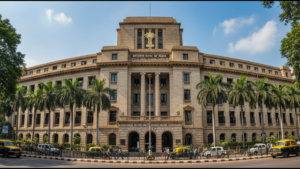Dear Aspirants,
Reasoning Questions for SBI PO/Clerk Mains 2018
Complexity of questions in Reasoning Ability for Banking and Insurance exams is increasing tremendously and one needs to put his nose on the grindstone while preparing for this section. Cracking questions of the Mains level will not be an easy task if one do not get into a habit of continuous practice of latest pattern based questions. And, to let you practice with the best of the latest pattern questions, here is the Adda247 Reasoning Quiz based on the latest pattern for SBI PO and Clerk Mains Exam. Not only this, these quizzes will also prove propitious for the upcoming Bank of Baroda Exam. Now, pull up your socks, it’s time to practice till perfection.
Direction (1-5): Read the following information and answer the questions that follow:
Seven persons P, Q, R, S, T, U and V attend workshop for developing managerial skills in seven different companies namely Accenture, HCL, TCS, Infosys, Tata, Tech Mahindra and Amdocs on different days of the week from Monday to Sunday and also they like some fruits viz.- Apple, Orange, Mango, Pineapple, Guava, Strawberry and Banana. The order of persons, companies, fruits and days of the week are not necessarily in the same order.
R attends workshop in Company Accenture but not on Tuesday. V attends workshop on Monday but not in TCS and Amdocs. U attends workshop in Tata on Friday. The one who works in Accenture likes Guava. Q attends workshop in Infosys on Wednesday. Two people attend workshop on the days between the days on which one who likes Guava and the one who likes Strawberry attend workshop. S, who likes Strawberry does not attend workshop in Accenture or TCS and attends workshop on the next day of the day on which T attends workshop, who attends the workshop in Tech Mahindra. The one who likes Pineapple attends workshop on the day just before the day on which R attends the workshop and three people attend the workshop on the days between the days on which the one who likes Apple and the one who likes Banana attend the workshop. The one who likes Orange attends workshop just before the day on which the one who likes Apple attends the workshop. The one who likes Mango attends workshop after the day on which the person who likes Apple attends the workshop.
Q1. Which of the following combinations of person-company-day and fruit is correct?
(a) V-HCL-Wednesday-Mango
(b) P-HCL-Monday-Orange
(c) V-TCS-Monday-Guava
(d) V-Amdocs-Sunday-Strawberry
(e) None of These
Q2. R attends the workshop on which day?
(a) Saturday
(b) Sunday
(c) Tuesday
(d) Thursday
(e) None of These
Q3. Four of the following five are alike in a certain way and hence they form a group. Which one of the following does not belong to that group?
(a) V
(b) Infosys
(c) Amdocs
(d) U
(e) Accenture
Q4. Which of the following persons, likes Orange?
(a) T
(b) S
(c) U
(d) R
(e) V
Q5. If V is related to Infosys-Mango in the same way as Q is related to Tata-Strawberry. Following the same pattern, find out P is related to which of the following?
(a) Infosys-Mango
(b) HCL-Pineapple
(c) Accenture-Guava
(d) TCS-Apple
(e) Accenture-Banana
Directions (6-10): Study the following information to answer these questions.
Seven Professors A, B, C, D, E, F and G are engaged in evaluation of answer papers in three different subjects English, Mathematics and History. At least two person evaluates the papers in each subject. Each of the evaluators stay in different buildings P, Q, R, S, T, V and W not necessarily in the same order.
A evaluates English papers only with E and stay in building R. D stays in building W and does not evaluate Math papers. The one who stay in building V evaluates History papers. B and C do not evaluate paper in the same subject. Those who evaluate English papers do not stay in building Q. F stays in building P but does not evaluate History papers. G evaluates same paper as F. C stays in building T.
Q6. Who stays in building V?
(a) E
(b) F
(c) G
(d) B
(e) None of these
Q7. Which of the following combinations of subjects, person and building is definitely correct?
(a) Math – F – Q
(b) Math – G – Q
(c) History – D – T
(d) History – E – S
(e) None of these
Q8. Which of the following groups of persons evaluate the Mathematics paper?
(a) CF
(b) EFG
(c) CFG
(d) FG
(e) None of these
Q9. Papers in which subject are evaluated by D?
(a) History
(b) Math
(c) English
(d) English or mathematics
(e) History or mathematics
Q10. E stays in which building?
(a) P
(b) Q
(c) T
(d) Cannot determined
(e) None of these
Directions (11-15): Study the following information carefully and answer the given questions.
A word and number arrangement machine when given an input line of words and numbers rearranges them following a particular rule in each step. The following is an illustration of input and rearrangement.
Input: set near 31 11 went 51 21 ago 71 toy 41 pink 61 colour
Step I: went set near 31 11 51 21 ago toy 41 pink 61 colour 61
Step II: went toy set near 31 11 51 21 ago 41 pink colour 61 71
Step III: went toy set pink near 31 11 21 ago 41 colour 61 71 41
Step IV: went toy set pink near colour 31 11 21 ago 61 71 41 51
Step V : went toy set pink near colour ago 11 21 61 71 41 51 21
Step VI: went toy set pink near colour ago 11 61 71 41 51 21 31
Step VII: went toy set pink near colour ago 61 71 41 51 21 31 1
Step VII is the last step of the above arrangement.
As per the rules followed in the steps given above, find out in each of the following questions the appropriate step for the given input.
Input: one 131 and 161 two 111 171 make 141 so 151 thus 121 near
Q11. Which step number would be the following output?
two thus so one near make and 111 121 161 171 141 151 121
(a) Step IV
(b) Step V
(c) Step VI
(d) Step VII
(e) There will be no such step
Q12. Which of the following would be fifth to the left of second to the right position from the right end in Step IV for the above input?
(a) and
(b) 111
(c) 121
(d) make
(e) None of these
Q13. How many elements (words or numbers) are there between ‘one’ and ‘131’ as they appear in the last step of the output?
(a) Six
(b) Eight
(c) Four
(d) Five
(e) Seven
Q14. Which of the following represents the position of ‘make’ in the fourth step?
(a) Ninth from the left
(b) Sixth from the left
(c) Fifth from the right
(d) Sixth from the right
(e) Both (a) and (d)
Q15. In the last step of the rearrangement, ‘151’ is related to ‘one’ and ‘141’ is related to ‘near’ in a certain way. Which of the following would ‘171’ be related to, following the same pattern?
(a) and
(b) thus
(c) make
(d) so
(e) None of these






 SEBI Grade A Admit Card 2025-26 Out @seb...
SEBI Grade A Admit Card 2025-26 Out @seb...
 RBI Assistant Notification 2026, 500+ Va...
RBI Assistant Notification 2026, 500+ Va...








